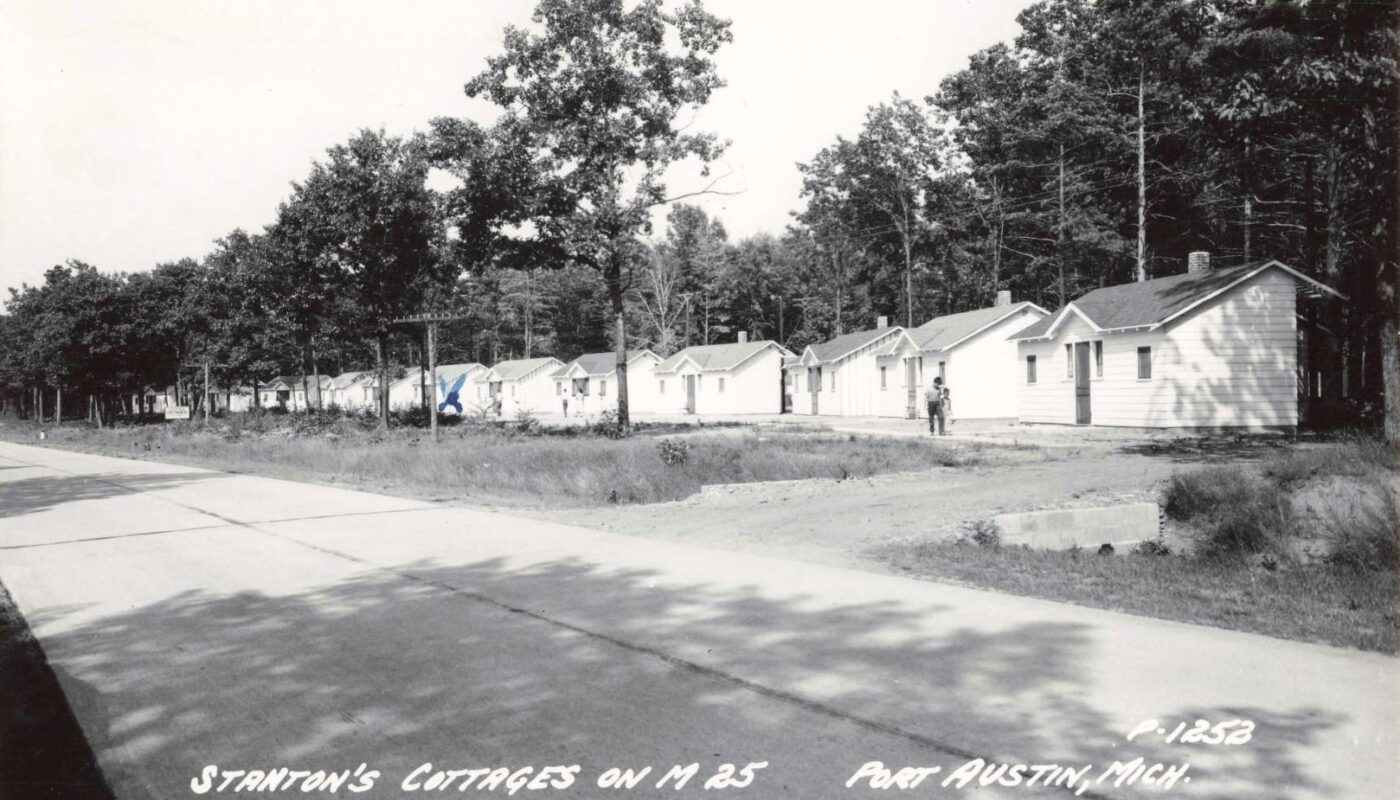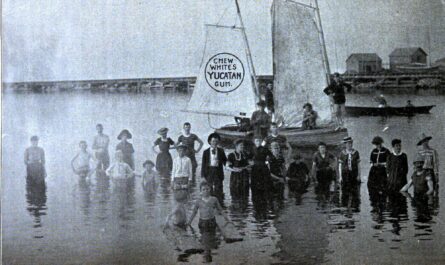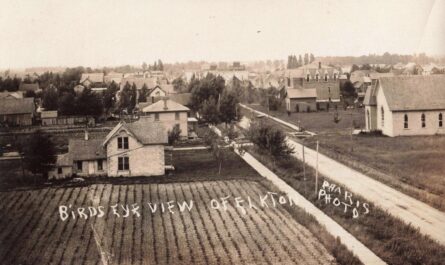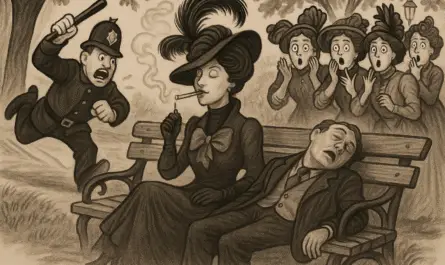These Port Austin’s roadside cabins offered families a budget-friendly place to rest, relax, and reconnect during the golden age of highway travel from the 1930s–60s. It also served to jumpstart the emerging tourist economy of the Upper Thumb during the Great Depression.
Cruising Michigan’s First Scenic Highway
Imagine it’s the late 1930s, and you’re motoring along a freshly paved highway at the top of Michigan’s Thumb. The road you’re on is M-25 – officially designated in 1940 as Michigan’s first Scenic Highway. This two-lane ribbon hugs the Lake Huron shore, treating you to glimpses of sandy beaches, towering hardwood forests, and the glittering blue water on the horizon. The nation is coming out of the Great Depression, and families are slowly hitting the road again. By 1940, local boosters proudly noted that “every accommodation for the tourist” lined this scenic route – “good hotels, restaurants, cottages, cabins, free camping grounds” – everything a road-tripper could need. In those days, signs along M-25 beckoned with promises of “Eat”, “Gas”, and “Cabins”, forming a lifeline of services around the Thumb.
As you drive into the village of Port Austin at the tip of the Thumb, you feel a cool lakeshore breeze. You might be coming from the city on a summer escape, eager to see local attractions like the strange rock formation known as Turnip Rock or to camp by the ruins of old Port Crescent in the new state park. The car is loaded with kids, fishing poles, and picnic baskets – a classic mid-century family road trip. After a long day’s drive, everyone’s looking forward to a friendly place to spend the night. Fortunately, Port Austin in the 1930s–1960s is dotted with mom-and-pop cabin courts ready to welcome travelers.
This was the golden age of automobile tourism, and local folks all along M-25 were turning their homes and farmland into informal resorts to cater to the motoring public. By the 1950s, postwar vacationers packing into their Chevys and Fords were exactly the kind of guests these family-run cottages and motor courts were built to serve. The stage is set: twilight is coming on, and the “Cabins – Vacancy” light is flickering on. Let’s pull over and explore some of Port Austin’s early roadside cabin stops.
Port Austin’s Roadside Cabins Resorts

Bay Crest Cabins was one of the quaint cabin clusters awaiting travelers on the outskirts of Port Austin. Tucked beneath big shade trees along what was then US-25, Bay Crest featured a handful of tidy little cabins set back from the road. On a warm evening you might find a family at the picnic table out front, unpacking a supper or playing cards in the dappled light filtering through the maples. Their car would be parked just steps from the cabin door – the ultimate convenience for weary motorists.
The cabins themselves were humble one-room structures with simple wood siding, but they provided all the essentials: a dry roof, a clean bed, and a bit of privacy in the northwoods air. Bay Crest Cabins exemplified the mid-20th-century trend of affordable roadside lodging that let middle-class families explore Michigan’s Thumb without breaking the bank. It was a shady, peaceful retreat where the sounds of crickets and Lake Huron’s breeze lulled travelers to sleep after a long day on the road.
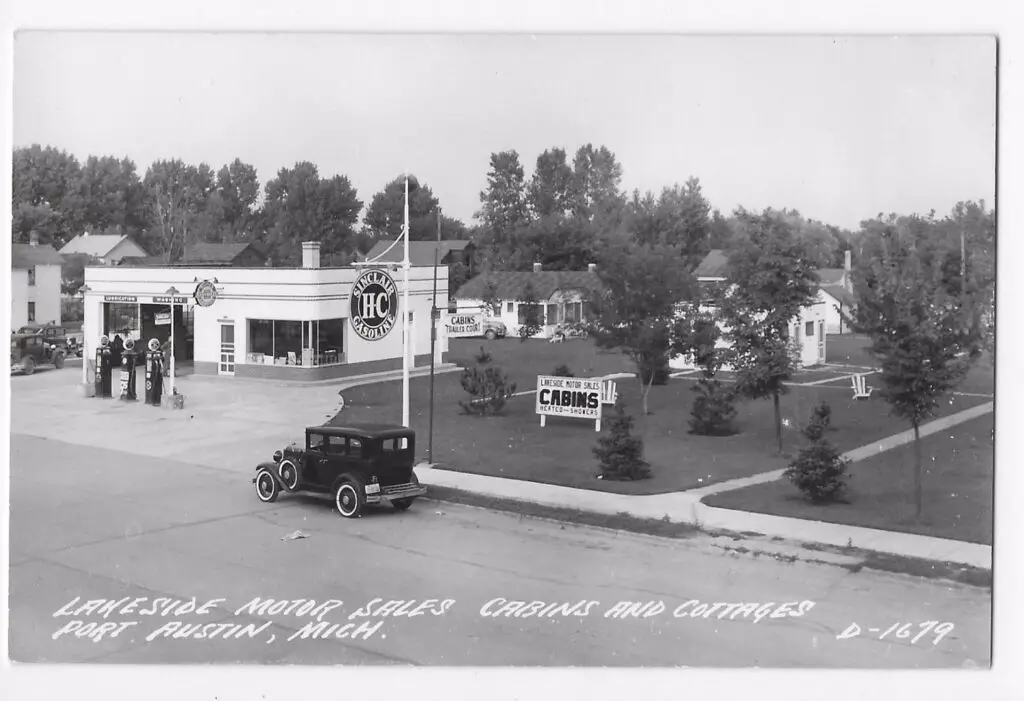
Lakeside Motor Sales Cabins and Cottages offered a more bustling stop right in Port Austin’s village – a true one-stop shop for travelers. Owned by local entrepreneur Ed Parks, who ran the Sinclair gas station and an auto sales business on site, Lakeside Motor Sales combined fuel, service, and lodging in one place. Picture pulling into a gleaming white Sinclair station with vintage “HC” globed gas pumps out front and a big Sinclair dinosaur sign by the curb. While an attendant topped off your tank and cleaned the windshield, you could stroll a few yards over to check into a cozy cabin for the night. A prominent sign on the lawn proclaimed “Lakeside Motor Sales – CABINS – Heated – Showers”, advertising modern comforts that not every roadside cabin could boast in the 1930s.
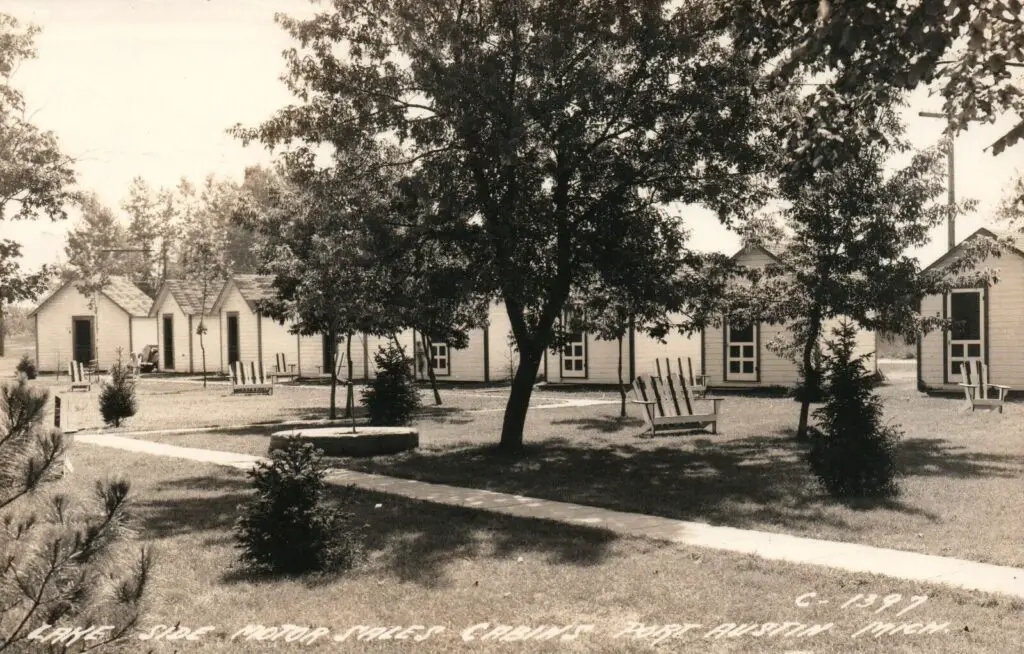
Scattered around the neat grassy court were a handful of small white cottages, each with green trim and a little screened porch. Adirondack chairs sat under young shade trees for guests to relax in the evening. Footpaths connected the cabins to the station and an office, making it feel like a miniature tourist village. Here a family could refuel both the car and themselves – perhaps grabbing a cold pop or ice cream from the station’s store – then settle into a clean, heated cabin with an indoor shower (a true luxury in the early days of motor travel!). Lakeside Motor Sales Cabins was the kind of place where the neon lights of the gas pumps and the warm glow from cabin windows created a reassuring oasis for 1940s travelers rolling into town after dark.
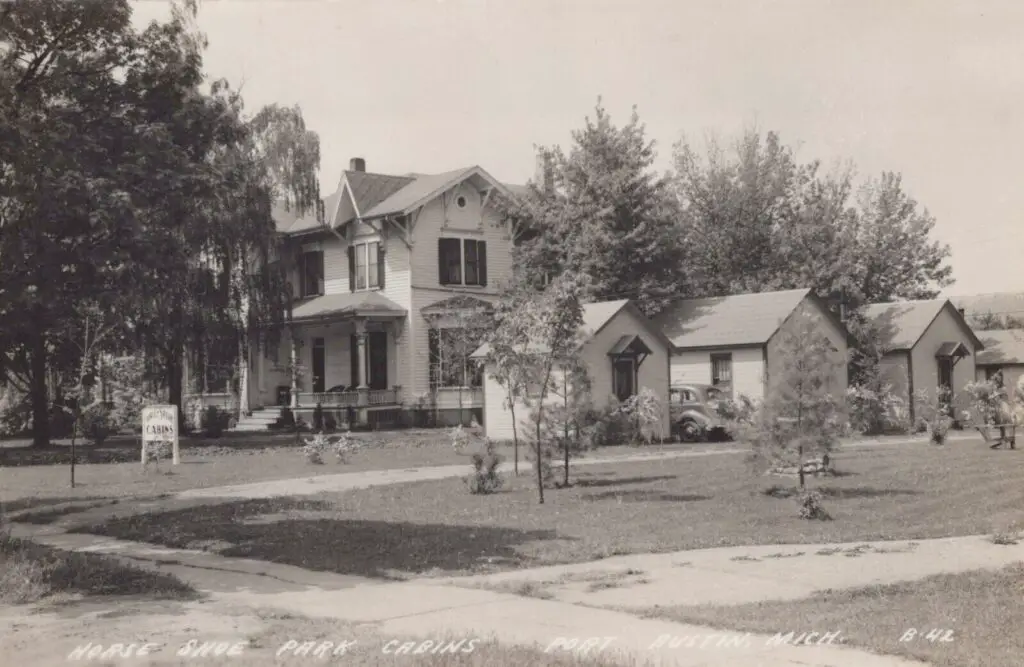
Horse Shoe Park Cabins brought a touch of Victorian charm to the roadside cabin scene. This property featured a grand old farmhouse-style home at its center – complete with gables, a wraparound porch, and ornate woodwork – which served as the owners’ residence and perhaps an office for guests. The name “Horse Shoe Park” likely came from the layout of its cabins: a semi-circle arrangement arcing around the big yard like a horseshoe. In the front lawn, a hand-painted sign reading “Horse Shoe Park Cabins” greeted arrivals, and just beyond it, you could see a row of small cottages nestled amid lilac bushes and birch trees.
This early 1940s photo shows three or four of these cabins lined up beside the main house, each with a tidy stoop and a peaked roof, looking like tiny versions of the family home itself. Guests who stayed here often felt more like houseguests than anonymous travelers – the proprietors might be sitting in rocking chairs on that big front porch ready to chat, and kids could play on the grass under the willow tree. In the evening, the porch light and a couple of yard lamps would illuminate the path to your cabin. Horse Shoe Park Cabins captured the homier side of tourism: a blend of bed-and-breakfast warmth and cabin-court simplicity, all under the care of a local family.
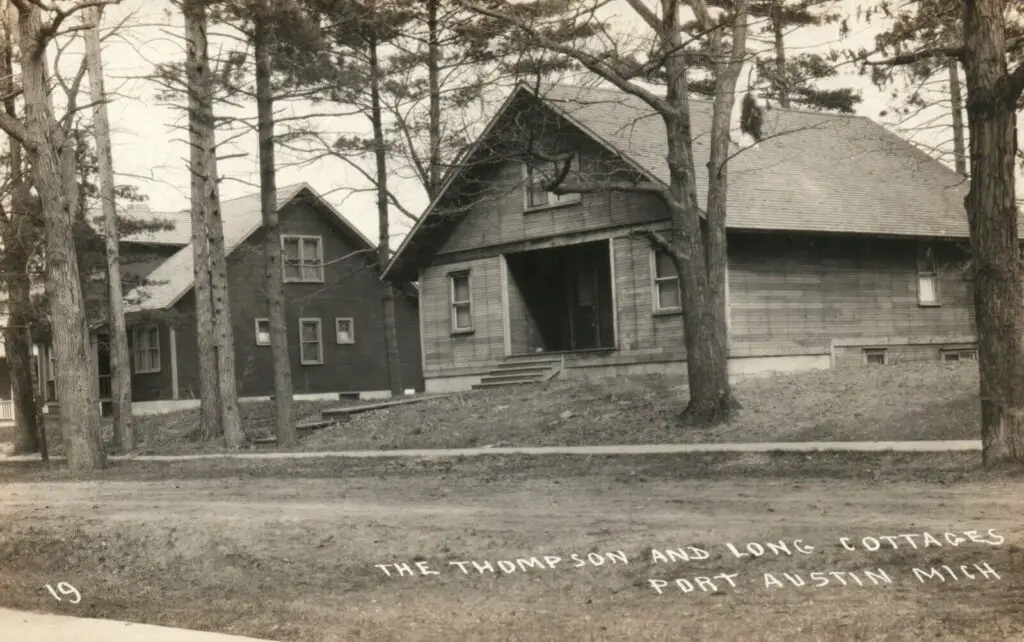
Just down the road, an establishment known as Thompson and Long Cottages offered a decidedly rustic ambiance. In fact, locals sometimes just called it “Long’s Log Cabins,” and one look at the place made it obvious why. The cabins here were built in a rough-hewn log style – sturdy little shacks with vertical log slab siding and screened front porches that made each unit look like a pioneer’s cottage. A surviving real-photo postcard proudly titles the scene “The Thompson and Long Cottages, Port Austin, Mich.”, showing a cluster of these log cabins arranged on a dirt clearing. In that image, you can almost taste the dust from the gravel road and hear the creak of the porch screen door.
This wasn’t fancy lodging by any stretch: the floors might be wooden or even just painted planks, and the furnishings likely minimal. But for many travelers in the 1940s, a night at Thompson & Long’s cabins was about adventure and authenticity. You could park your car right in front of your cabin, unload the fishing gear, and feel like you were “roughing it” in the north woods (with a few basic amenities, of course). Come nighttime, guests might light up a shared fire pit or charcoal grill out front, swap stories, and roast marshmallows under the stars. The rustic vibe of Thompson and Long Cottages gave city folks a little taste of the simpler life – a throwback even then – which was a big part of the era’s vacation culture.
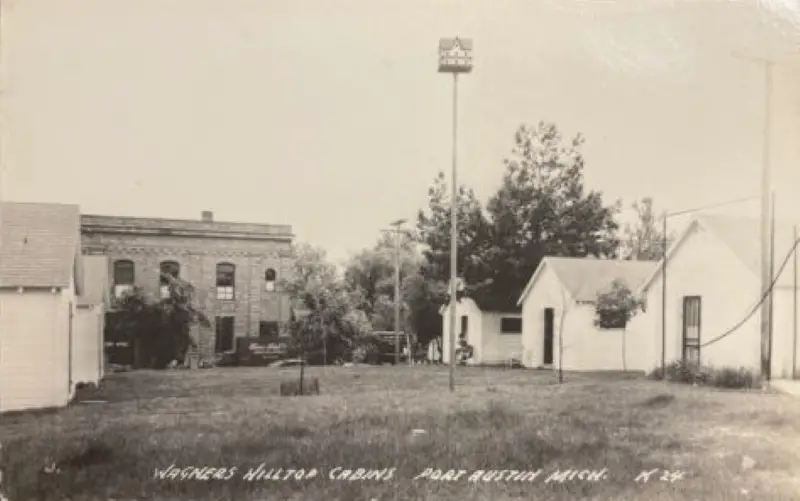
On a slight rise near town stood Wagners Hilltop Cabins, a cozy motor court that literally and figuratively rose above the others. Perched just beyond the main village, Wagner’s had a handful of plain white cabins spaced around a grassy yard. In the center of the grounds was a tall pole mounted with a light or sign, rising high like a beacon. At night, that light would have been visible from down the road, guiding road-weary drivers up to the “hilltop.”
The cabins themselves were unassuming—simple clapboard structures with a single door and window—but they offered a quiet retreat set back from the highway. Being on a hill, a traveler might catch a view of the surrounding countryside or even a distant glimpse of Lake Huron’s horizon from here. One traveler in the 1950s might recall pulling into Wagner’s Hilltop after sunset: the proprietor (The Wagner’s, presumably) would come out of the brick office building to check you in, and you’d park beside your little cabin under the glow of that tall yard light. In the morning, the rise provided a lovely vantage to see the sun peeking over the treetops and hear birds singing. Wagner’s Hilltop Cabins offered a tranquil, slightly elevated rest stop, giving families a sense of being tucked away in their own corner of Port Austin for the night.
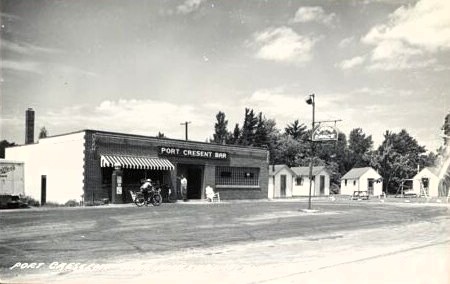
Heading west out of Port Austin on M-25, the road grows quieter and trees thicker. There you’d come across the Port Crescent Bar Cabins, a unique combination of roadhouse and overnight lodging. The Port Crescent Bar itself was a single-story tavern with a false-front façade and an awning – the kind of place where neon beer signs buzzed in the window and a couple of motorcycles might be parked out front on any given afternoon.
It took its name from the nearby ghost town of Port Crescent, a once-thriving lumber port that vanished in the 1880s. (In fact, an enormous 125-foot brick chimney, left from the old sawmill, still stood as a lonely sentinel behind the trees, giving travelers something to gawk at.) Beside the bar, you would see a few white cabins peeking out from the woods. They were available for rent, making the establishment a perfect all-in-one pit stop: you could grab a hot meal and a cold drink at the bar, swap stories with locals or other travelers, then walk a few steps over to your cabin when it was time to turn in.
The cabins at Port Crescent Bar were basic but convenient – each with a small porch and set a little apart for privacy. Imagine a couple on their honeymoon road trip in the 1950s, dancing to jukebox tunes in the tavern earlier, now retiring to a little cabin where the distant sound of lake waves mixes with the chirp of crickets. It was this mix of roadside merriment and easy lodging that made Port Crescent Bar Cabins a memorable stopover. You weren’t just spending a night; you were experiencing a sliver of Thumb culture – where hospitality, a bit of local history, and a good time all met on the side of M-25.
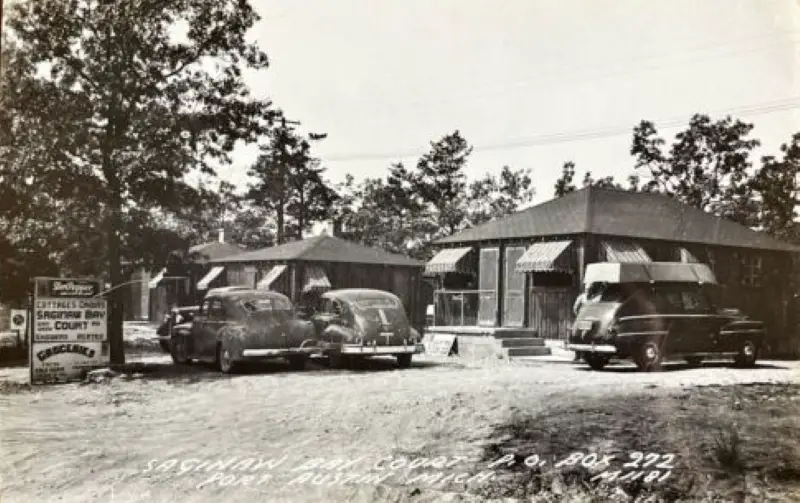
Finally, near the water’s edge was Saginaw Bay Court, often one of the last Thumb motor courts travelers would encounter heading south or one of the first when coming up from the Bay City side. Saginaw Bay Court was a string of humble cabins right along the shoreline, offering an incredible proximity to the lake. An old photograph shows a row of weathered wooden cabins with cars parked practically at the doors, and just beyond them, the open expanse of Saginaw Bay gleaming under the sky.
Staying here meant you could fall asleep to the gentle sound of waves lapping the shore and wake up to a brilliant sunrise over the water. The cabins were small and rustic, likely constructed of plain boards and perhaps unpainted or stained dark by the elements, but they had character. Each had a little stoop and maybe a bench outside, so you could sit with a cup of coffee in the morning, watching gulls and fishing boats out on the bay. Families often spent a week here in the 1950s, using it as a base for fishing excursions or beach days – essentially an early form of the “lake cottage” vacation.
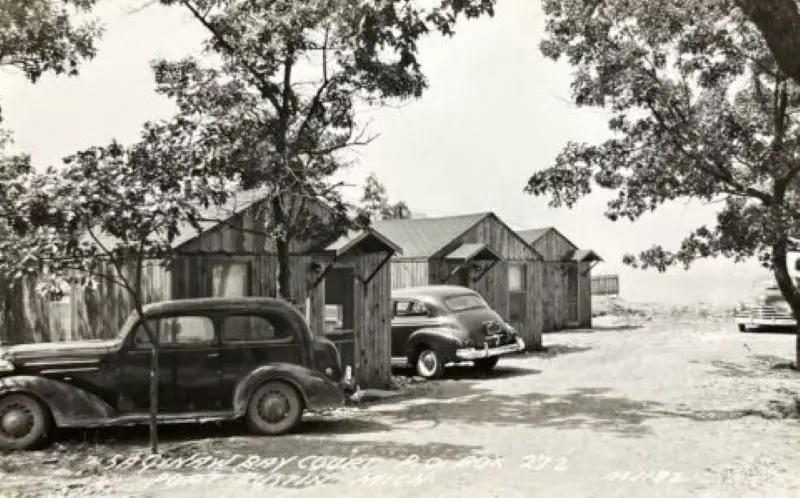
The lake breeze kept things cool even in July, and the kids could run straight from the cabin to the beach to splash in the water. Saginaw Bay Court encapsulated everything appealing about lakeshore travel in that era: simplicity, natural beauty, and the freedom to step out your door onto sand. For many travelers, these little bayside cabins were the ultimate reward after navigating miles of open road.
The Legacy of Port Austin’s Motor Courts
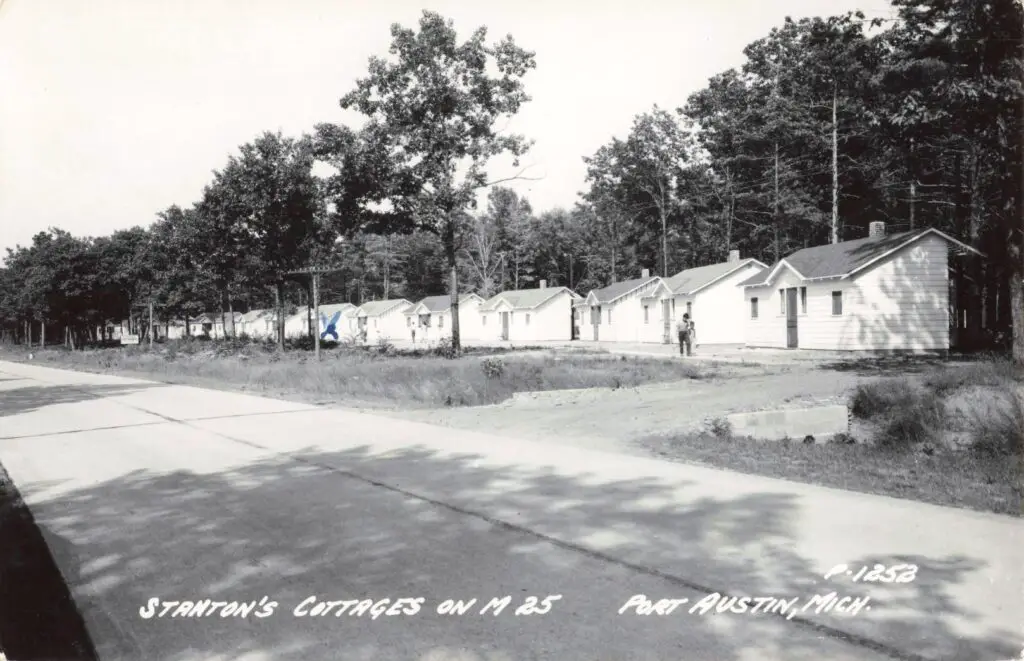
In the three decades from the 1930s through the 1960s, places like Port Austin showed countless Americans what road-trip freedom was all about. The roadside cabins and motor courts of that era reflected a vacation culture that was casual, adventurous, and family-oriented. Parents, kids, and even the family dog could pile into the car and drive until they found a welcoming sign that said “Cabins” – no reservations needed, just a friendly wave from a proprietor who likely lived right on the property.
These cabin clusters were more than just lodgings; they were experiences in themselves. Travelers remember the neon signs humming at dusk, the smell of campfire smoke mixed with lake air, and the eclectic sights – from gas pumps and diner neon, to clotheslines behind cabins fluttering with beach towels. Each motor court had its own personality: some offered modern amenities like hot showers and electricity, others provided a nostalgic rustic charm that made you feel closer to the land. All of them, however, played a key role as stopovers for families exploring Michigan’s Thumb, stitching together the journey with memories of simple pleasures.
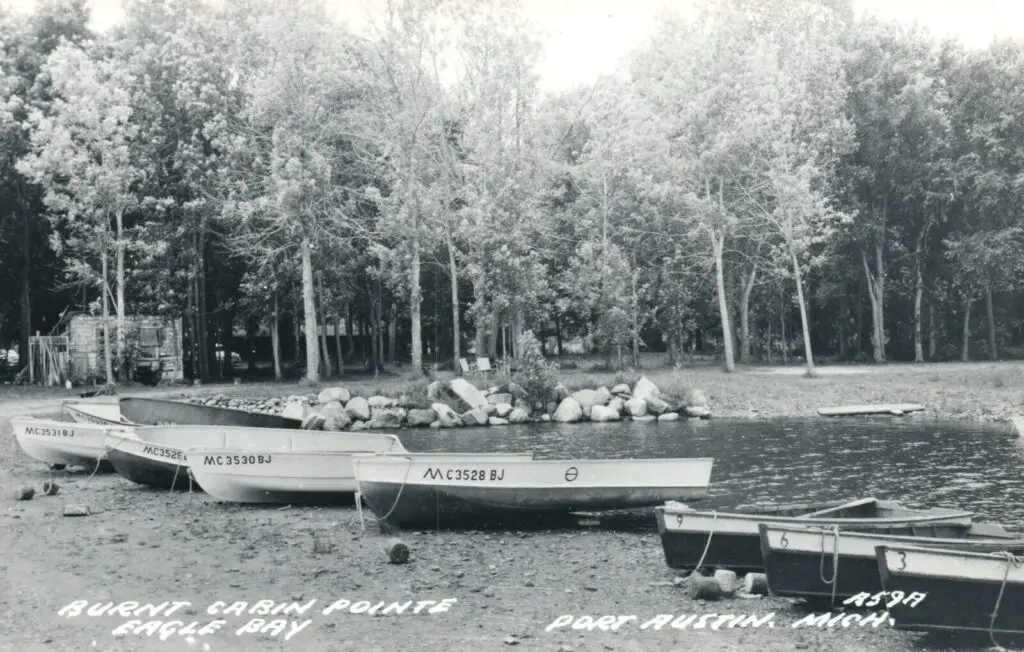
By the late 1960s, the era of the classic tourist cabin was beginning to fade – new interstate highways and bigger chain motels started drawing travelers away from the old two-lanes. Many of Port Austin’s beloved cabin courts either closed, modernized, or were repurposed over time Yet, the legacy of those early tourism days lives on. Next time you cruise M-25 around the Thumb, imagine it 60 or 70 years ago: cars with wood-paneled sides and license plates from all over, winding along the lake, discovering these little oases of hospitality at each bend.
Port Austin’s early roadside cabins helped define an age when the journey was just as exciting as the destination – a friendly cabin under the pines at day’s end being the perfect finish to a long day’s drive. And in today’s Port Austin, if you listen closely, you might still hear echoes of those times in the laughter around a beach bonfire or the quiet goodnight between travelers as they turn in, dreaming of another sunny road ahead.
Sources for Port Austin’s Roadside Cabins
Parks, Edward. Personal papers and correspondence. Archives of Lakeside Motor Sales, Port Austin, Michigan. Privately held collection. Background and operational details on Lakeside Motor Sales Cabins and Sinclair service.
“Scenic Highways in Michigan.” Michigan Department of Transportation, 1940. Archive record via State of Michigan Library. Describes the designation of M-25 as a scenic highway and early road conditions in the Thumb.
Tinder, David V. David V. Tinder Collection of Michigan Photography, Bentley Historical Library. University of Michigan, 1850–1990s. https://quod.lib.umich.edu/b/bhl Source of vintage postcards and real-photo images of Port Austin cabin courts.
Hardy, Michael. “Vintage Cabins and Lost Motor Courts in Port Austin, Michigan.” Thumbwind Publications, 2024. https://thumbwind.com Blog analysis of surviving Port Austin tourist accommodations from the 20th century.
“The History of Port Crescent State Park.” Michigan Department of Natural Resources, State Parks Centennial Series, 2019. https://www.michigan.gov/dnr Covers the historical context of the Port Crescent area and its transition into parkland.
“Tourism and Travel in Michigan’s Thumb.” Huron Times, special summer edition, The Times Herald
Port Huron, Michigan · Wednesday, June 22, 1949 Period newspaper coverage describing roadside tourism in Huron County post-WWII.

